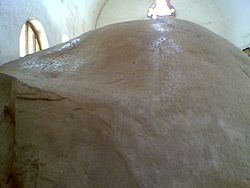Sudarshana Lake
| Sudarshana Lake | |
|---|---|
 | |
| Location | Bhavnath, Girnar, Gujarat |
| Coordinates | 22°57′N 73°19′E / 22.950°N 73.317°E |
| Lake type | Ancient lake, Man-made lake |
| Native name | (language?) |
| Settlements | Girnar |
Sudarshan Lake, also known as Sudarshan Sarovar, is a historic man-made reservoir located on Girnar Hill in Saurashtra, Gujarat, India. It is renowned for its historical significance, ecological value, and scenic beauty.[1]
History[edit | edit source]
Inscription[edit | edit source]
| Jungadh rock inscription of Rudradaman I | |
|---|---|
 The inscribed rock | |
| Writing | Sanskrit, Brahmi script |
| Created | circa 150 AD |
| Place | Junagadh, Gujarat |
| Present location | near Girnar mountain |
The inscription on the Junagadh Rock is approximately 5.5 feet in height and 11 feet in width, comprising twenty lines of varying lengths. The first sixteen lines are extensively damaged, with significant portions missing due to both deliberate vandalism and natural rock deterioration. This loss accounts for about 15% of the original text. In contrast, the final four lines are well-preserved and remain intact.[2] According to Kielhorn, the inscription uses an early form of the alphabet that evolved into the "decidedly southern alphabet" seen in later Gupta Empire inscriptions and those of Skandagupta. The characters are approximately 7/8 inches in height.[3][4] The Western Satraps who succeeded Rudradaman did not adopt the literary style of this inscription. Instead, they preferred a more informal, hybrid Sanskrit.[3] The inscription itself provides a historical account of the water management and irrigation systems at Sudarshan Lake, tracing its development from the era of Chandragupta Maurya (321-297 BCE) up to around 150 CE when the inscription was created. The final twelve lines of the inscription are dedicated to praising King Rudradaman I, referred to as "garland of Rudra."[2][3][5]
| English translation |
|---|
|
Founding and Renovations[edit | edit source]
Sudarshan Lake, located in Gujarat, India, has a rich historical background documented in various inscriptions. According to the Junagadh Rock Inscription of 150 CE, Sudarshan Lake was constructed in 320 BCE by Pushyagupta Vaishya, a provincial governor, on the orders of Emperor Chandragupta Maurya. Later, during Emperor Ashoka's reign, his governor Tushasp extended the lake by creating a canal from it.[8][9] In 72 Shaka Era, This artificial reservoir was repaired in 150 AD by Rudradaman King Rudradaman I, he restored the lake's embankments, which had been damaged by a storm.[10] The dam was breached again during Rudradaman’s time due to heavy rainfall, but no extra taxes were imposed for repairs.[11] The Skandagupta inscription of 456 AD notes that Chakrapalit, the son of Parndatt, repaired the lake’s dam after it was damaged by excessive rain.[12]
Water Source and Location[edit | edit source]
Situated approximately 900 meters above sea level, the lake offers panoramic views and a tranquil environment. Historically, the lake was crucial for the region, providing essential water resources for agriculture and sustaining local life.[13]
Legacy[edit | edit source]
Sudarshan Lake exemplifies Indian engineering and resilience, underscoring the vital role of water management in ancient civilizations. The lake's natural beauty and serene setting attract tourists and pilgrims, making it a significant site for both religious reflection and leisurely visits.
See also[edit | edit source]
External links[edit | edit source]
References[edit | edit source]
- ↑ Chaurasia, Radhey Shyam (2002). History of Ancient India: Earliest Times to 1000 A. D. Atlantic Publishers & Dist. p. 300. ISBN 978-81-269-0027-5.
- ↑ 2.0 2.1 F. Kielhorn, Junagadh Rock Inscription of Rudradaman, Epigraphia Indica, Volume VIII, No. 6, pages 36-49
- ↑ 3.0 3.1 3.2 Salomon, Richard (1998). Indian Epigraphy: A Guide to the Study of Inscriptions in Sanskrit, Prakrit, and the other Indo-Aryan Languages. Oxford University Press. pp. 89–90. ISBN 978-0-19-535666-3.
- ↑ Ichimura, Shōhei (2001). Buddhist Critical Spirituality: Prajñā and Śūnyatā. Motilal Banarsidass Publisher. p. 45. ISBN 9788120817982.
- ↑ Dilip K. Chakrabarti (1999). India, an Archaeological History: Palaeolithic Beginnings to Early Historic Foundations. Oxford University Press. pp. 294–295. ISBN 978-0-19-564573-6.
- ↑ Epigraphia Indica, Vol. VIII. Calcutta: Office of the Superintendent of Government Printing, 1905-6, 45-49
- ↑ "Junagadh Rock Inscription of Rudradaman", Project South Asia.Archived 23 February 2009 at the Wayback Machine
- ↑ Singh, Upinder (2008). A History of Ancient and Early Medieval India: From the Stone Age to the 12th Century. Pearson Education India. p. 380. ISBN 978-81-317-1120-0.
... Sudarshana lake by the mahakshatrapa Rudradaman . The construction of this reservoir was started by Vaishya Pushyagupta , the provincial governor of Chandragupta Maurya . It was completed by the Yavana Tushaspha , governor of the Ashoka.
- ↑ Pandey, Vimal. Prachin Bharat Ka Itihas (Ancient India), Hindi Edition. S. Chand Publishing. p. 114. ISBN 978-81-219-2205-0.
- ↑ Tripathi, Ramashankar. Pracheen Bharat Ka Itihas. p. 199.
- ↑ Shaikh, Dr Shahajahan B. (2017-09-04). Archaeological Study of Kandhar (Dist. Nanded, Maharashtra). p. 28. ISBN 978-1-387-15993-2.
While considering the history of India, it appears that kings, noblemen, and the rich created ponds and lakes thinking it their duty and maintained them well In Girnar mountains in Saurashtra, Chandragupta Maurya's (324- BC) regent Pushya of Dhant built Sudarshana lake by rain water harvesting. Later on Ashoka's depute Tushasph renovated it and made the waiter of the lake available for irrigation. Around 150 AD when tha lake was washed away by heavy rains, the King Mahakshatrapa Rudradaman repaired it.
- ↑ Jayaswal, Vidula (2001). Royal Temples of Gupta Period: Excavations at Bhitari. Aryan Books International. p. 9. ISBN 978-81-7305-207-1.
..the repair of the Sudarshan lake and construction of two temples by Chakrapalita, the son of the governor of Saurashtra, Parnadatta, who was appointed by the monarch, Skandagupta.
- ↑ Rangachari, Devika (2022-12-13). The Mauryas: Chandragupta to Ashoka: The Backstories, The Sagas, The Legacies. Simon and Schuster. ISBN 978-93-92099-33-5.
